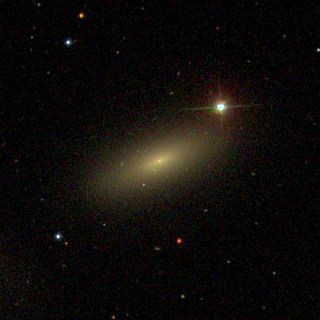
NGC 1512 is a barred spiral galaxy approximately 38 million light-years away from Earth in the constellation Horologium. The galaxy displays a double ring structure, with a (nuclear) ring around the galactic nucleus and an (inner) further out in the main disk. The galaxy hosts an extended UV disc with at least 200 clusters with recent star formation activity. NGC 1512 is a member of the Dorado Group.

NGC 475 is a lenticular galaxy in the constellation Pisces. It is located approximately 750 million light-years from Earth and has a diameter of roughly 125 thousand light-years. NGC 475 was discovered on November 3, 1864 by German astronomer Albert Marth.

NGC 4436 is a lenticular or dwarf elliptical galaxy located about 60 million light-years away in the constellation of Virgo. NGC 4436 was discovered by astronomer William Herschel on April 17, 1784. The galaxy is a member of the Virgo Cluster.

NGC 490, also occasionally referred to as PGC 4973 or GC 277, is a lenticular galaxy in the constellation Pisces. It is located approximately 85 million light-years from Earth and was discovered on December 6, 1850, by Irish engineer Bindon Blood Stoney. Although John Dreyer, creator of the New General Catalogue, credits the discovery to astronomer William Parsons, he notes that many of his claimed discoveries were made by one of his assistants. In the case of NGC 490, the discovery was made by Bindon Stoney, who discovered it along with NGC 486, NGC 492 and NGC 500 during his observation of NGC 488.

NGC 4503 is a barred lenticular galaxy located around 41 to 74 million light-years away in the constellation Virgo. NGC 4503 was discovered by astronomer William Herschel on March 15, 1784. NGC 4503 is a member of the Virgo Cluster.

NGC 505 is a lenticular galaxy approximately 234 million light-years away from Earth in the constellation of Pisces. It was discovered by German astronomer Albert Marth on October 1, 1864.

NGC 509 is a lenticular galaxy approximately 87 million light-years away from Earth in the constellation of Pisces. It was discovered by German astronomer Albert Marth on October 1, 1864.

NGC 4872 is a barred lenticular galaxy located about 310 million light-years away in the constellation of Coma Berenices. NGC 4872 has been indicated to contain an active galactic nucleus. NGC 4872 was discovered by astronomer Heinrich d'Arrest. It is a member of the Coma Cluster.

NGC 805 is a lenticular galaxy approximately 194 million light-years away from Earth in the constellation of Triangulum. It was discovered by German astronomer Heinrich Louis d'Arrest on September 26, 1864, with the 11-inch refractor at Copenhagen.

NGC 966 is an unbarred lenticular galaxy approximately 440 million light-years away from Earth in the constellation of Cetus. It was discovered by American astronomer Francis Preserved Leavenworth in 1886.

NGC 1190 is a lenticular galaxy approximately 109 million light-years away from Earth in the constellation of Eridanus. It was discovered by American astronomer Francis Leavenworth on December 2, 1885 with the 26" refractor at Leander McCormick Observatory.

NGC 1191 is a lenticular galaxy approximately 406 million light-years away from Earth in the constellation of Eridanus. It was discovered by American astronomer Francis Leavenworth on December 2, 1885 with the 26" refractor at Leander McCormick Observatory.

NGC 1199 is an elliptical galaxy approximately 107 million light-years away from Earth in the constellation of Eridanus. It was discovered by William Herschel on December 30, 1785.

NGC 1192 is a lenticular galaxy approximately 417 million light-years away from Earth in the constellation of Eridanus. It was discovered by American astronomer Francis Leavenworth on December 2, 1885 with the 26" refractor at Leander McCormick Observatory.

NGC 504, also occasionally referred to as PGC 5084 or UGC 935, is a lenticular galaxy located approximately 189 million light-years from the Solar System in the constellation Pisces. It was discovered on 22 November 1827 by astronomer John Herschel. The object was listed twice in the General Catalogue, precursor of the New General Catalogue, as both GC 291 and GC 292.

NGC 5114 is a lenticular galaxy located about 170 million light-years away in the constellation Centaurus. The galaxy was discovered by astronomer John Herschel on June 3, 1836.

NGC 4551 is an elliptical galaxy located about 70 million light-years away in the constellation Virgo. It was discovered by astronomer William Herschel on April 17, 1784. NGC 4551 appears to lie close to the lenticular galaxy NGC 4550. However, both galaxies show no sign of interaction and have different red shifts. Both galaxies are also members of the Virgo Cluster.

NGC 6043 is a lenticular galaxy located about 444 million light-years away in the constellation Hercules. NGC 6043 was discovered by astronomer Lewis Swift on June 27, 1886. The galaxy is a member of the Hercules Cluster.

NGC 4578 is a lenticular galaxy located about 55 million light-years away in the constellation Virgo. NGC 4578 was discovered by astronomer William Herschel on January 18, 1784 and is a member of the Virgo Cluster.

NGC 3317is a barred lenticular galaxy located about 190 million light-years away in the constellation Hydra. The galaxy was discovered by astronomer John Herschel on March 26, 1835. NGC 3316 is a member of the Hydra Cluster, and appears to have a small companion galaxy known as HCC 15.




















